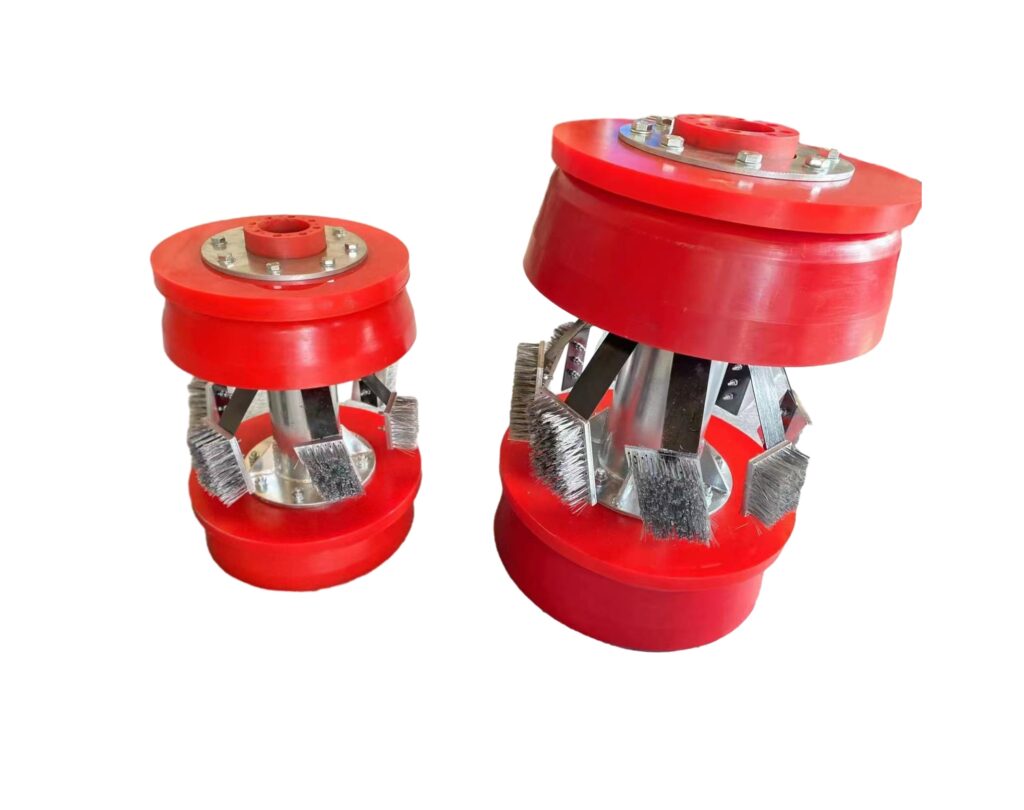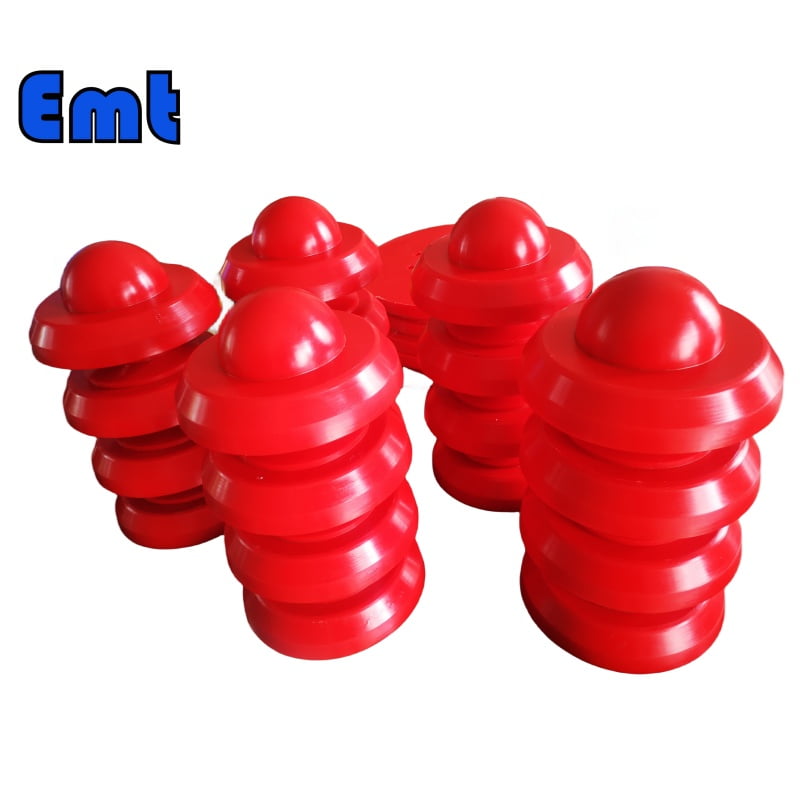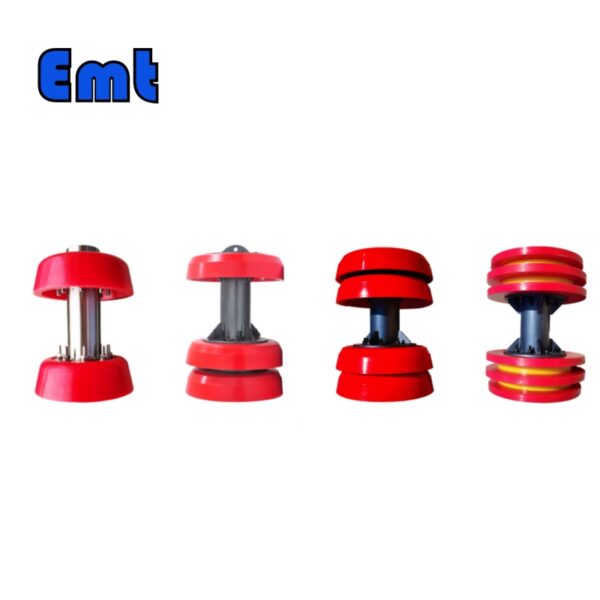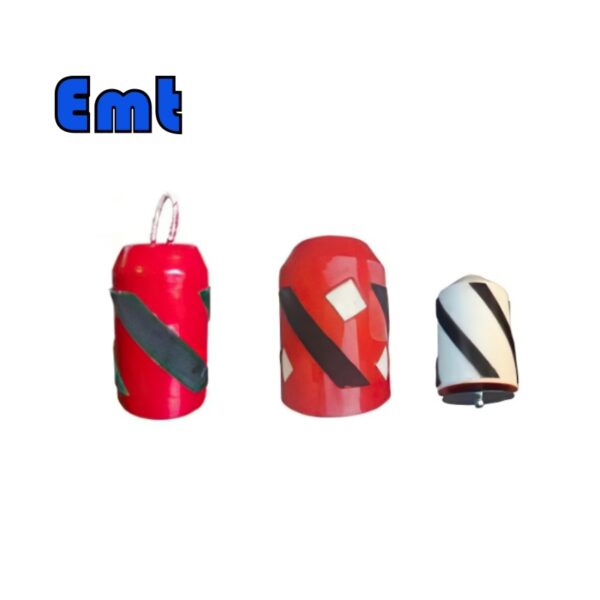Descripción
 Comprensión de los cerdos de limpieza de tuberías
Comprensión de los cerdos de limpieza de tuberías
Un Pipeline Pigging Pig, que significa "dispositivo de intervención de tuberías", es una herramienta que se utiliza para limpiar o revisar tuberías en todos los pasos del proceso de transmisión de petróleo y gas. Se cree que el apodo de "cerdo" se originó a partir del ruido de "chillido" que hacían los primeros modelos de cerdos (elaborados con paja, alambre o cuero) mientras viajaban a través de tuberías.
Pigging en oleoductos y gasoductos
La práctica del pigging en la industria del petróleo y el gas es un aspecto vital del aseguramiento del flujo. Los raspadores de tuberías se aprovechan para purgar, limpiar e inspeccionar las tuberías, asegurando su buen funcionamiento. Sólo profesionales experimentados deben realizar el raspado debido a los riesgos potenciales que implica.
Introducción del cerdo de limpieza de tuberías
EMT es un diseñador y fabricante líder de una amplia gama de raspadores para tuberías, cada uno diseñado específicamente para aplicaciones particulares. Su catálogo de productos es extenso e incluye cerdos para diversos fines, como desplazamiento de líquidos, limpieza, dosificación, medición e incluso cerdos especiales para tareas únicas y desafiantes.
La selección de pigs para tuberías que ofrece EMT no sólo es diversa en su aplicación sino también en su construcción. Están disponibles en diámetros de hasta 60 pulgadas y se adaptan a un amplio espectro de tamaños de tuberías. Además, el nivel de agresividad de los cerdos se puede elegir en función de la tarea en cuestión, desde cerdos firmes de uretano hasta aquellos equipados con cepillos de alambre de acero para una limpieza intensa.
Una de las principales fortalezas de EMT son las opciones de personalización y configuración que ofrece. Entienden que cada tubería es única y, por lo tanto, requiere una solución personalizada. EMT tiene en cuenta factores como el diámetro de la tubería, el tipo de sustancia que se transporta, las condiciones internas de la tubería y los requisitos específicos del cliente. Al hacerlo, se aseguran de que cada cerdo que fabrican se adapte exactamente a la tarea para la que está destinado.
Esta apuesta por la personalización se extiende no sólo a las características físicas de los cerdos sino también a su funcionalidad. Ya sea que se trate de un raspador para limpieza básica, inspección avanzada o tareas complejas multifunción, EMT tiene la capacidad de diseñar y fabricar un raspador que se ajuste a sus necesidades. Su flexibilidad y adaptabilidad garantizan que incluso las condiciones más complejas de las tuberías puedan gestionarse de forma eficaz.
Métodos de extracción de cerdos y elección de métodos de extracción de cerdos
(1) Eliminación de cera en oleoductos de crudo mediante pigging de tuberías
Los oleoductos de crudo que transportan petróleo ceroso con frecuencia encuentran acumulación de cera a lo largo de las paredes del oleoducto. Cuando la capa de cera alcanza un espesor significativo, es necesario iniciar un proceso de limpieza de la tubería para limpiarla. Esta práctica no sólo disminuye los costos operativos sino que también aumenta la capacidad del oleoducto. Para ejecutar esta operación, es importante seleccionar cerdos blandos adecuados y cerdos mecánicos equipados con rastreadores de cerdos.
El proceso de pigging de la tubería comienza lanzando un raspador suave para evaluar el estado interno de la tubería. Una vez verificada la integridad de la tubería, se introducen raspadores mecánicos, un tipo de raspador de tuberías, para la operación de limpieza. Estos raspadores mecánicos eliminan de manera eficiente las impurezas y los desechos en la tubería, aprovechando sus cepillos de acero para erradicar los depósitos de cera y la corrosión de las paredes de la tubería.
(2) Métodos de limpieza con cerdos para tuberías de gas natural utilizando cerdos tradicionales
Los gasoductos naturales suelen transportar gases como dióxido de carbono y sulfuro de hidrógeno. Estos gases pueden formar hidratos en presencia de agua, lo que provoca bloqueos de tuberías y equipos y riesgos para la seguridad. Por lo tanto, estas tuberías requieren limpieza con cerdos tradicionales, como cerdos de cuenco de cuero, antes de comenzar las operaciones. Estos raspadores son particularmente efectivos para tuberías que transportan gases húmedos, ya que su función principal es eliminar el agua de la tubería. Para esta tarea, con frecuencia se elige un raspador de placa recta conocido por su rendimiento de sellado superior. Si la tubería se origina en un sótano o campo de gas que contiene condensados de hidrocarburos ligeros, se pueden utilizar cerdos de placa recta directamente para su eliminación.
(3) Limpieza de tuberías de gas natural que transportan una mezcla de petróleo y agua utilizando raspadores de tuberías específicos
Para tuberías de gas natural que han estado operativas durante un largo período y transportan flujo bifásico, pueden surgir problemas como acumulación de líquido y corrosión de las paredes internas. Estos líquidos generalmente se acumulan en los puntos más bajos de la tubería, lo que provoca una mayor caída de presión y un área de flujo reducida.
Varios factores pueden influir en la eficacia del proceso de pigging de una tubería de flujo de dos fases: el caudal permitido y la caída de presión de la mezcla gas-líquido, la relación gas-líquido, la forma de la sección longitudinal de la tubería, la cantidad de líquido acumulado y la tamaño del instrumento atrapador de clavijas. En los sistemas de tuberías costa afuera, la parte inferior del tubo ascendente y la altura del instrumento de captura del tapón de líquido también desempeñan un papel. Para estas tuberías normalmente se utilizan cerdos y bolas de raspado de uso general. Sin embargo, también se pueden utilizar raspadores de tubería con derivación para el proceso de raspado.
Mejores prácticas para el pigging seguro y eficiente de gasoductos de gas natural de larga distancia
(1) Planificación adecuada de las operaciones de pigging: garantizar la seguridad en la pigging de tuberías de gas natural de larga distancia
La perforación de gasoductos de gas natural de larga distancia conlleva riesgos inherentes. Un manejo inadecuado puede provocar que el raspador de la tubería se atasque, lo que requerirá un corte en la tubería para recuperar el raspador y podría causar fugas de gas. Por lo tanto, las lecciones de operaciones de limpieza previas enfatizan la planificación cuidadosa. El paso inicial en el proceso de pigging debe ser lanzar un raspador de placa recta para exploración y detección para evaluar el estado interno de la tubería. Las operaciones de limpieza posteriores deben ejecutarse metódicamente, alinearse con las circunstancias específicas y priorizarse sobre la velocidad.
(2) Estándares detallados de limpieza de tuberías: clave para una limpieza de tuberías segura y eficiente
La complejidad y los riesgos potenciales que implica la perforación de gasoductos de gas natural de larga distancia exigen una planificación meticulosa y estándares de limpieza precisos. Los trabajadores primero deben reunir todos los dibujos y datos relevantes de la tubería para comprender los parámetros específicos de la tubería y las condiciones del mundo real. En base a esto, se debe diseñar un plan de limpieza integral y lógico, detallando los procedimientos operativos paso a paso.
Las inspecciones iniciales de los gasoductos se pueden realizar utilizando cerdos de espuma. Si la tubería está en buenas condiciones con daños mínimos, se puede utilizar una copa de cuero con forma de mariposa para un tratamiento adicional. Por ejemplo, si los residuos en la pared de la tubería pesan menos de 20 kg, se puede emplear una placa de aluminio de un diámetro adecuado. Si la tubería no presenta daños importantes ni curvaturas severas, se pueden usar raspadores de placa recta para transmisión bidireccional. Es fundamental cumplir con los procedimientos estándar establecidos durante el proceso de limpieza de tuberías y evitar apresurar la tarea.
(3) Pigging eficiente de gasoductos de gas natural de larga distancia: función de la preparación y la gestión
Para una supervisión y gestión efectivas, los operadores de limpieza deben estar adecuadamente preparados antes de comenzar la operación de limpieza. Antes del raspado, todos los componentes, como las válvulas de admisión y escape, deben recibir un mantenimiento e inspección rigurosos. Además, los taladros con tecnología pigging deben reforzarse para evitar chispas provocadas por colisiones o fricción durante su uso.
Ciertos pasos exigen una atención cuidadosa. Por ejemplo, cuando la bola de limpieza se recoge en el cilindro, se debe reemplazar con nitrógeno para reducir su diferencia de presión. Se debe instalar una válvula de equilibrio en la junta reductora del cilindro de bolas. Durante un impulso lento, las válvulas de entrada y salida del cilindro de bolas deben abrirse secuencialmente y luego cerrarse la válvula de equilibrio. Esto garantiza que la operación del servicio se lleve a cabo de forma segura y eficaz.
Conclusión
Pipeline Pigging Pigs, diseñados y fabricados por empresas como EMT, son herramientas esenciales utilizadas en la industria del petróleo y el gas para limpiar, inspeccionar y mantener tuberías. Disponibles en una variedad de tamaños y niveles de agresividad, estos raspadores se pueden adaptar a las condiciones específicas de la tubería y a los requisitos del cliente. Se utilizan para diversos fines, incluido el desplazamiento de líquidos, la limpieza, la dosificación, la medición y más. El tipo de cerdo utilizado depende de la naturaleza de la sustancia que se transporta y de las condiciones internas de la tubería. Por ejemplo, los pigs blandos y los pigs mecánicos se utilizan a menudo para la eliminación de cera en oleoductos, los pigs tradicionales para gasoductos y los pigs de uso general o aquellos con derivación para tuberías que transportan un flujo de dos fases. El uso del raspador apropiado y el cumplimiento de estándares y procedimientos de raspado detallados garantiza la seguridad, eficiencia y efectividad de las operaciones de la tubería.

 English
English العربية
العربية Deutsch
Deutsch Bahasa Indonesia
Bahasa Indonesia Português
Português Русский
Русский Español
Español






Reseñas
Aún no hay reseñas.